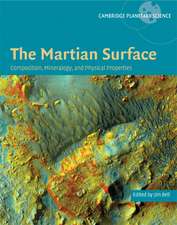Earth-Moon Relationships: Proceedings of the Conference held in Padova, Italy at the Accademia Galileiana di Scienze Lettere ed Arti, November 8–10, 2000
Editat de Cesare Barbieri, Francesca Rampazzien Limba Engleză Paperback – 20 noi 2013
Preț: 1230.53 lei
Preț vechi: 1500.64 lei
-18% Nou
Puncte Express: 1846
Preț estimativ în valută:
235.47€ • 251.79$ • 196.32£
235.47€ • 251.79$ • 196.32£
Carte tipărită la comandă
Livrare economică 17 aprilie-01 mai
Preluare comenzi: 021 569.72.76
Specificații
ISBN-13: 9789401038553
ISBN-10: 9401038554
Pagini: 588
Ilustrații: X, 575 p. 244 illus., 2 illus. in color.
Dimensiuni: 160 x 240 x 35 mm
Greutate: 0.81 kg
Ediția:Softcover reprint of the original 1st ed. 2001
Editura: SPRINGER NETHERLANDS
Colecția Springer
Locul publicării:Dordrecht, Netherlands
ISBN-10: 9401038554
Pagini: 588
Ilustrații: X, 575 p. 244 illus., 2 illus. in color.
Dimensiuni: 160 x 240 x 35 mm
Greutate: 0.81 kg
Ediția:Softcover reprint of the original 1st ed. 2001
Editura: SPRINGER NETHERLANDS
Colecția Springer
Locul publicării:Dordrecht, Netherlands
Public țintă
ResearchCuprins
Welcome Address.- Goodly Frame, Spotty Globe: Earth and Moon in Renaissance Literature.- Sediments of the Moon and Earth as End-Members far Comparative Planetology.- The Moon in the 14th Century Frescoes in Padova.- The Importance of the Moon in Teaching Astronomy at the Primary School.- The Moon and the Origin of Life.- Sexual Satellites, Moonlight and the Nuptial Dances of Worms: The Influence of the Moon on the Reproduction of Marine Animals.- Abstract: Claire de Lune on the Italian Space Science Programme.- Fantastic New Chondrites, Achondrites, and Lunar Meteorites as the Result of Recent Meteorite Search Expeditions in Hot and Cold Deserts.- Lunar Influences on Climate.- Apollo Samples and the Geochemical Determination of Basaltic Achondrite Parent Bodies.- Abstract: Water: Communicator in Moon-Earth Relationships.- “Lunacy” in Mentally Disturbed Children.- Highlights from ICEUM4, the 4th International Conference on the Exploration and Utilisation of the Moon.- The D-CIXS X-Ray Spectrometer on ESA’s SMART-1 Mission to the Moon.- Lunar and Planetary Perspectives on the Geological History of the Earth.- Moonstruck: How Realistic is the Moon Depicted in Classic Science Fiction Films?.- The Moon and Extra-Solar Planets.- Craters on the Moon from Galileo to Wegener: A Short History of the Impact Hypothesis, and Implications for the Study of Terrestrial Impact Craters.- Reckoning Time, Longitude and the History of the Earth’s Rotation, Using the Moon.- Ancient Moons.- The Formation of Chemical Elements and Their Abundances in the Solar System.- A New View of the Moon in Light of Data from Clementine and Prospector Missions.- The Atmosphere of the Moon.- The Moon and Life on Earth.- Marine Animal Behaviour in Relation to Lunar Phase.- Moon-Struck: ArtistsRediscover Nature and Observe.- Nitrogen on the Moon: What Does It Tell Us?.- Search for Antimatter in Cosmic Rays Using the Moon.- Abstract: Mysteries of the Farside of the Moon: What Galileo Couldn’t See.- Lunar Maps of the 17th and 18th Centuries. Tobias Mayer’s Map and its 19th-Century Edition.- SMART-I: The First Time of Europe to the Moon. Wandering in the Earth-Moon Space.- Palaeolithic Timekeepers Looking at the Golden Gate of the Ecliptic; The Lunar Cycle and the Pleiades in the Cave of La-Tête-du-Lion (Ardèche, France) — 21,000 BP.- Lunar Influence on Plants.- A Perspective on the Earth from the Moon.- “Earth-Moon Relationships”: Highlights of the Conference and Concluding Remarks.- The Dispute between Carlini-Plana and Laplace on the Theory ofthe Moon.- Abstract: On the Orbit of the Moon.- Geochemical Evidence for a Close Genetic Relationship of Earth and Moon.- Macro and Microcosmus: Moon Influence on the Human Body.- Lunar Rhythms in Forestry Traditions — Lunar-Correlated Phenomena in Tree Biology and Wood Properties.- Meteor Showers on the Lunar Atmosphere.- LUNAM 2000 (Lunar Atmosphere Mission).- Earthshine at the Rainbow Angle.- Seneca and the Moon: The Cultural Importance of Our Satellite.- The Moon, the Stars and the Milk.- Abstract: Science Fiction in Naples in the Middle of the 19th Century.- Moonlight without the Moon.- The Science Goals of ESA’s SMART-1 Mission to the Moon.- Lunar Explorers Society: Goals and Activities.- Lunation and Primate Menses.- Abstract: Mapping the Moon with SIR, An Infrared Spectrometer for SMART-1.- Radioastronomy and Radiointerferometry on the “Hidden” Lunar Surface.- The Moon in the Classic Maya World.- The Response of the 11 August 1999 Total Solar Eclipse in the Geomagnetic Field.- Variations inthe Mortality with Respect to Lunar Phases.











